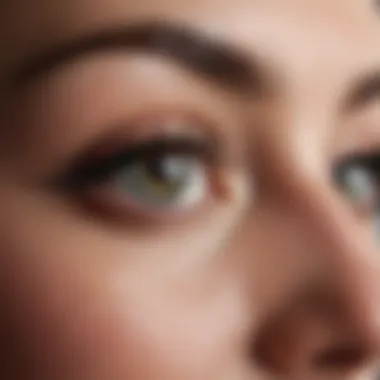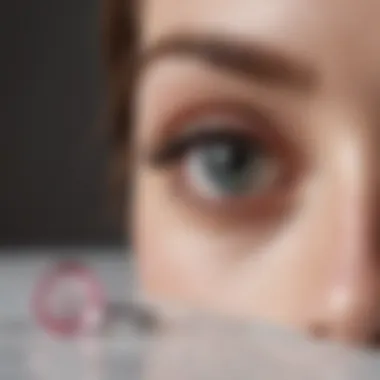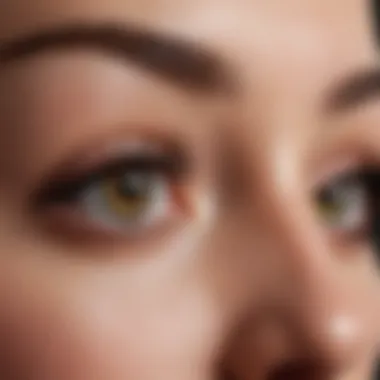Mastering Mascara Removal: Essential Techniques


Intro
Mascara serves as one of the most crucial components of makeup routines for many individuals. It can enhance the eyes, providing a defined and captivating look. Although its benefits are numerous, removing mascara poses a significant challenge. Mishandled removal methods can lead to damaged or weakened eyelashes, causing concern among beauty enthusiasts. Thus, understanding effective techniques for mascara removal is essential. This guide delves into various methods, exploring both chemical and natural solutions for achieving clean, intact eyelashes.
Beauty Tips and Tricks
Effective mascara removal starts with understanding the right techniques and practices. Here are some tips that can help enhance the removal process:
- Choose the Right Product: The type of mascara you use greatly influences how it should be removed. Waterproof mascaras demand more robust removal methods compared to standard formulas.
- Create a Skincare Routine: Ensuring regular care for your skin, especially around the eye area, adds to the overall health of your eyelashes. Incorporate a gentle cleanser tailored for sensitive areas into your skincare routine.
- Gentle Application: When applying mascara, be careful not to overload the lashes. Excess product can make removal harder, potentially contributing to lash loss.
Expert Beauty Advice
Incorporating insights from professionals can promote more effective mascara removal. Expert advice emphasizes the following aspects:
- Professional Makeup Artist Insights: Many artists recommend using their fingers or a cotton pad soaked in remover rather than wipes. This method provides better control and minimizes the pulling on delicate lashes.
- Skincare Specialist Recommendations: Opt for oil-based removers if you wear waterproof mascara. Oil effectively breaks down the product without harsh rubbing, safeguarding your lashes.
- Hair Stylist Tips: Healthy hair, including eyelashes, often results from proper care. Using a nourishing serum for lashes can aid in recovery after removal.
Product Reviews
Identifying suitable products is crucial for effective mascara removal. Here are some standout offerings:
- Burt's Bees Eye Makeup Remover: This gentle, natural formula cleanses and protects eyelashes while ensuring minimal irritation.
- Neutrogena Oil-Free Eye Makeup Remover: Known for its powerful, yet gentle formula, it's a go-to for those who frequently wear waterproof mascara.
- Garnier SkinActive Micellar Cleansing Water: This product acts as a versatile makeup remover suitable for various makeup types, including mascara.
Final Thoughts
This guide outlines several effective techniques and products for mascara removal, emphasizing the need for gentle care to maintain the health of your eyelashes. Mastering these methods not only preserves makeup integrity but also supports the well-being of delicate eyelashes. Understanding the importance of proper cleaning techniques can transform your beauty routine for the better.
Understanding Mascara
Understanding mascara is essential in the broader context of makeup application and removal. Mascara enhances the eyes and can transform a look from simple to striking. However, the process of cleaning it effectively is just as crucial, as improper removal can lead to lash damage and eye irritation. Thus, a comprehensive grasp of mascara types, formulations, and their intended purposes not only enhances your application skills but also informs the best methods of removal. This foundation ultimately guides users towards safer practices, ensuring the beauty routine is sustainable and health-conscious.
Definition and Purpose
Mascara is a cosmetic product designed to enhance the appearance of eyelashes. It typically comes in a tube and is applied with a brush or wand. The main purpose of mascara is to darken, lengthen, and volumize the lashes, making the eyes appear larger and more defined. This enhancement can create a more dramatic look, suitable for various occasions, from everyday wear to special events.
Types of Mascara
With a range of formulations available, knowing the types of mascara can help users choose the right one for their desired effects. Each type serves a specific need and comes with its distinct characteristics.
Waterproof Mascara
Waterproof mascara is known for its unique ability to withstand moisture. This characteristic makes it a popular choice for long wear or in situations prone to tears and humidity. Its formulation includes waxes and oils, which helps it adhere firmly to the lashes. Despite its advantages, waterproof mascara presents a challenge when it comes to removal, often requiring harsher chemicals or specific removers that can sometimes irritate the delicate area around the eyes.
Volumizing Mascara
Volumizing mascara is formulated to give the lashes a fuller appearance. It contains ingredients designed to coat each lash more thickly than regular mascara. This creates a dramatic, bold effect that is appealing to many users who want their lashes to pop. While volumizing mascara can enhance looks significantly, it can also lead to clumping if not applied correctly, requiring careful application techniques.
Lengthening Mascara
Lengthening mascara focuses on making eyelashes appear longer. This type typically includes fibers or polymers that attach to the ends of each lash, creating an illusion of length. The key characteristic of lengthening mascara is its ability to separate lashes, thus providing a more lined and defined look. However, some users may find that it does not provide much volume, which is a consideration for those who seek fuller lashes as well.
There exists a variety of formulations and functions in the mascara world, each suited for different beauty needs. By understanding these differences, one can make informed choices when selecting products and adopting removal techniques that prioritize eyelash health.
Importance of Proper Cleaning
The way mascara is cleaned from eyelashes has significant implications not only for makeup integrity but also for overall eye health. Proper cleaning techniques play a vital role in maintaining the delicate balance of eyelash and eye care, which is often overlooked in beauty routines. It is essential to approach mascara removal with knowledge and care to avoid complications such as irritation, infection, or damage to the lashes themselves.
Avoiding Eye Irritation


One of the primary reasons to focus on proper cleaning is to avoid eye irritation. The skin surrounding the eyes is sensitive and can easily react to harmful substances. If mascara is not removed thoroughly, residue can accumulate. This residue may lead to discomfort, redness, and even allergic reactions.
Common symptoms of irritation include:
- Redness of the eyes
- Itchiness or swelling
- Discomfort during blinking
Moreover, leftover mascara can trap bacteria, increasing the risk of infections such as conjunctivitis. Regular, gentle cleaning practices can reduce the likelihood of these issues. Use suitable removal products that are hypoallergenic and formulated for sensitive areas. This will help minimize the risk of irritation and maintain a healthy eye environment.
Maintaining Eyelash Health
Another critical aspect of proper cleaning is ensuring the health of eyelashes. Just as skin requires maintenance, eyelashes also need care. Neglecting to clean mascara effectively can lead to breakage and weakening of the lashes over time. It is crucial to remove mascara properly to prevent lashes from becoming brittle and prone to falling out.
Some benefits of maintaining eyelash health include:
- Improved Growth: Regular cleaning supports the natural growth cycle of eyelashes. Clogged follicles can hinder growth, making well-maintained lashes appear fuller.
- Reduced Loss: Lashes are less likely to break or fall out when they are clean and well cared for.
- Enhanced Appearance: Healthy lashes contribute to a more vibrant and attractive look, making mascara application more effective.
Using conditioning serums after cleaning can further support lash health. Ingredients such as biotin and peptides help nourish and strengthen lashes, fostering a more robust growth environment.
"Proper mascara removal is not just about looking good; it is about preserving the health of your eyelashes and the delicate skin around your eyes."
Methods of Mascara Removal
Removing mascara correctly is key to maintaining healthy eyelashes. If mascara is not taken off properly, it can lead to various issues, such as irritation, dryness, or even loss of eyelashes. This section will explore both chemical and natural methods of removing mascara, providing readers with comprehensive options suited to their needs. Each method has its unique qualities, advantages, and limitations, offering a range of possibilities for achieving clean and healthy lashes.
Chemical Removers
Chemical removers are widely used and offer effective solutions for mascara removal. They are generally easy to find and can work quickly, allowing for efficient makeup removal. In this section, we will cover three prominent types of chemical removers: oil-based makeup removers, micellar water, and makeup wipes. Each has its strengths and weaknesses, providing options depending on an individual’s preferences.
Oil-Based Makeup Removers
Oil-based makeup removers are particularly known for their effectiveness in dissolving waterproof formulas. They work by breaking down the components of the mascara, making it easier to wipe away. The key characteristic of oil-based removers is their ability to penetrate and lift stubborn makeup without excessive rubbing.
One unique feature of oil-based makeup removers is their moisturizing properties. Many options include ingredients that not only remove the mascara but also nourish the lashes. However, they can leave a residue that some may find unpleasant. It's crucial to ensure thorough rinsing after use to avoid any greasy feel.
Micellar Water
Micellar water is another popular choice among makeup enthusiasts. It's a gentle solution that contains tiny micelles, which act like magnets to attract and lift dirt and makeup from the skin. The key characteristic of micellar water is its versatility; it can be used without rinsing and is suitable even for sensitive skin.
A unique feature of micellar water is its lightweight formula, making it easy to carry and use on the go. It is generally considered to be less irritating than harsher products, but it may require more effort to fully remove thick or waterproof mascara. For best results, using a sufficient amount of product is necessary.
Makeup Wipes
Makeup wipes are known for their convenience and portability. They come pre-moistened and are designed to remove makeup quickly. The key characteristic of makeup wipes is their ease of use; they are an excellent choice for travel or quick cleanups.
One unique feature of makeup wipes is that they can vary in the quality and formulation. Some wipes are infused with beneficial ingredients, such as aloe or vitamin E, to help soothe the skin. However, they can sometimes irritate sensitive skin or cause dryness, which is important to consider. Also, they might not be as effective on stubborn or long-wearing formulas, requiring multiple wipes.
Natural Solutions
Natural solutions offer an alternative for those who prefer using gentler, more wholesome ingredients. They are often favored for being free from chemicals and artificial additives. This section highlights three natural solutions for mascara removal: coconut oil, olive oil, and aloe vera gel. Each has its advantages and serves well in the quest for clean eyelashes.
Coconut Oil
Coconut oil is highly praised for its conditioning properties. When used for mascara removal, it effectively breaks down product and hydrates the eyelashes at the same time. The key characteristic of coconut oil is its ability to penetrate hair fibers, providing deep nourishment to the lashes.
A notable feature of coconut oil is its pleasant scent and natural composition. It's free from harsh chemicals, making it ideal for sensitive areas like the eyes. On the downside, some individuals may find it difficult to remove all residue, requiring a gentle rinse afterward to ensure clarity.
Olive Oil
Olive oil is another natural option that shares similar benefits with coconut oil. Its primary role in mascara removal includes effectively breaking down makeup while also offering moisturizing benefits. The key characteristic of olive oil is its high antioxidant content, which promotes health and vitality in eyelashes.


One unique feature of olive oil is its non-comedogenic nature, meaning it won’t clog pores around the eyes. This oil can sometimes feel heavier than others, which may concern some users. Rinsing may be necessary after use to prevent any greasy layers left on the eyelashes.
Aloe Vera Gel
Aloe vera gel is known for its soothing properties and is great for sensitive skin. When used to remove mascara, it offers gentle cleansing without irritation. The key characteristic of aloe vera gel is its hydrating properties, helping to keep eyelashes strong and healthy.
A benefit of using aloe vera gel is its multipurpose nature; it can also provide soothing relief for various skin irritations. Although effective for light makeup removal, it may not be as powerful against waterproof formulations. Therefore, users may need to combine it with a stronger oil or remover for optimal results.
It is essential to be mindful of the method chosen for mascara removal. Each option has its strengths and limitations, and individual skin sensitivities should guide the selection process.
Step-by-Step Mascara Removal Techniques
To efficiently and safely remove mascara, a structured approach is necessary. This section delves into essential techniques that not only make the removal process effective but also safeguard the health of your eyelashes. Proper techniques ensure that residue is minimized and irritation is avoided, thus maintaining the overall health and appearance of your lashes.
Preparing for Removal
Gathering Required Tools
Gathering the right tools is crucial for successful mascara removal. This preparation phase involves selecting specific items that will aid in the overall process. Key characteristics of effective tools include softness, absorbency, and suitability for sensitive areas like the eyes. For example, using high-quality cotton pads is often a preferred choice. They provide enough surface area to cover the lashes, and are gentle on the skin.
One unique feature of cotton pads is their ability to retain moisture, which is essential when applying a remover. Moist pads prevent excessive rubbing and pulling, which can lead to eyelash damage or irritation. However, some may find that cotton pads can leave behind fibers on lashes, requiring additional cleaning steps.
Choosing the Right Environment
Creating an optimal environment for mascara removal can significantly impact the ease of the task. A well-lit space is essential; proper lighting allows for better visibility of the lashes, which helps in avoiding missed spots. Additionally, a comfortable environment reduces stress, making the process smoother.
A key characteristic of an effective space involves minimizing distractions. This ensures that attention is focused on the removal process. The unique benefit of a secluded area is that it provides the opportunity to take time and care, which generally leads to better results. On the downside, removing mascara in a less-than-ideal setting—like while multitasking—can lead to rushed actions and poor results.
Applying the Remover
Using Cotton Pads
Employing cotton pads to apply the mascara remover is a common practice for a reason. The pads facilitate an even application of the product over the lashes. This method allows for a targeted approach, as the cotton conforms to the shape of the eye, ensuring a thorough cleaning.
An important characteristic of using cotton pads is their efficiency in absorbing the remover, which helps in breaking down the mascara. While this is generally a helpful trait, pads may sometimes soak too much remover, leading to dripping. Care must be taken to avoid overly wetting the pads to prevent excess product from entering the eye area.
Using Fingers
Another method for applying mascara remover involves using fingers. This approach can be more precise, especially for those who wish to control the pressure and areas treated. The warmth of fingers may also assist in breaking down stubborn mascara, which is a key benefit.
One unique feature of using fingers is that it may feel more comfortable to some. This method does not use additional materials, which can mean less waste. However, the primary drawback is that hands must be thoroughly clean to avoid introducing bacteria into the eye area, a critical point of consideration.
Wipe Away the Mascara
Gently Using a Wiping Motion
When it comes to removing the mascara, gentleness is paramount. A wiping motion that is soft and deliberate prevents damage to the lashes and the sensitive skin surrounding the eyes. This technique is beneficial because it dislodges mascara without the harshness of rubbing.
The key characteristic of this gentle motion is its focus on grace rather than force. Using this technique can effectively maintain the integrity of eyelashes. However, care must be taken to ensure the mascara is properly dissolved before wiping, as ineffective removal can create a need for repeated actions, which counteracts the gentleness intended.
Removing Residue
Post-removal, addressing any remaining residue is essential. This step is often overlooked but is crucial to ensure no leftover product causes irritation or affects the health of the lashes. A careful check can highlight any missed spots, which aids in restoring the clean state of your eyelashes.
The unique characteristic of taking time for this stage is that it contributes to the overall cleanliness of the eye area. By ensuring that all remnants of mascara are wiped away, you reduce the risk of future irritation. However, one must be cautious that the pressure applied during this step remains gentle, as excessive force can be harmful. Taking these steps carefully can yield a clear and healthy finish to the mascara removal process.
Remember, each step in removing mascara matters. The health of your eyelashes relies on careful consideration of tools, techniques, and post-removal care.


Common Mistakes to Avoid
In the process of mascara removal, certain mistakes can lead to adverse effects on your eyelashes and overall eye health. Understanding these common errors is crucial for ensuring a safe and effective cleaning procedure. Proper removal techniques not only protect the integrity of the lashes but also reduce the risk of irritation or damage. This section will delve into two primary mistakes that individuals frequently make when trying to remove mascara, highlighting the importance of careful practices.
Rubbing Too Hard
One significant mistake is the tendency to rub the eyelashes vigorously during mascara removal. This practice can cause excessive friction, leading to lash breakage and even pulling out your eyelashes. The skin around the eyes is delicate, and the lashes themselves are susceptible to damage. Instead of rubbing, it is advisable to use gentle pressing motions with a cotton pad soaked in your chosen remover. Allow the product to break down the mascara without forceful actions.
Benefits of a gentle approach include:
- Preserving Lash Integrity: Soft motions help in maintaining the quality and longevity of your eyelashes.
- Reducing Irritation: Gentle removal minimizes the chances of redness or swelling around the eyes.
- Better Result: By allowing the remover to work, you can effectively remove mascara without excessive effort.
Using Harsh Products
Another critical error involves the use of harsh or aggressive chemical products for mascara removal. Many individuals reach for strong cleansers, thinking they are more effective. However, such products can lead to retinal exposure or skin irritation. It is essential to choose removers that are specifically designed for eye makeup. Products that are gentle, such as those marked as ophthalmologist-tested or suitable for sensitive eyes, are ideal.
Using the right products can offer several advantages:
- Safety First: Gentle removers are less likely to cause stinging or discomfort in your eyes.
- Nutritional Support: Some products are formulated with nourishing ingredients that can benefit eyelash health.
- Effective Cleaning: Well-designed formulas can remove mascara thoroughly without compromising the skin or lashes.
"Always prioritize your eye health when selecting makeup removers. Gentle is better."
Aftercare for Eyelashes
After removing mascara, it is crucial to focus on eyelash aftercare. This step often gets overlooked, yet it plays a significant role in maintaining the health and integrity of your eyelashes. Proper aftercare addresses potential damage caused by makeup removal, ensuring your lashes remain strong and vibrant. Moreover, it can reduce the risk of irritation and promote overall lash growth.
Hydration Techniques
To support the health of your lashes, hydration is essential. Just like skin, eyelashes can become dry and brittle, especially after using makeup removers. Several techniques can assist in providing needed moisture to your lashes.
Using Conditioning Serums
Conditioning serums serve as an effective option for lash aftercare. These products typically contain nourishing ingredients designed to strengthen and moisturize eyelashes. The key characteristic of conditioning serums is their formulation, which often includes peptides and natural extracts known for promoting hair health.
Using conditioning serums can be beneficial because they not only hydrate lashes but also promote growth. However, one must pay attention to the ingredients as some serums may cause irritation for sensitive individuals. The unique feature of these serums lies in their ability to provide a protective coat to the lashes, making them resistant to external damage.
Natural Oils for Nourishment
Natural oils also play an important role in nourishing eyelashes. Oils like castor oil, almond oil, and coconut oil are popular choices for aftercare. Their key characteristic is their rich content of vitamins and fatty acids, which are vital for hydrating and strengthening lashes. Many users prefer natural oils due to their minimal nature and skin-friendly properties.
Natural oils can be advantageous as they are easily accessible and often cost-effective. However, they may not integrate well with everyone’s beauty routine, especially for those who prefer lighter products. Their unique feature is the ability to deepen the hydration effect over time, making them a worthwhile aspect of lash aftercare.
When to Seek Professional Help
Even with the best aftercare routines, situations may arise where professional assistance is necessary. Individuals might consider consulting a specialist if they notice excessive eyelash loss or persistent irritation. Professional help should also be sought if there is a reaction to certain products or if the lashes seem significantly more fragile than usual. Addressing these issues with an expert can lead to a tailored care plan, ensuring the health and beauty of your eyelashes.
End
Cleaning mascara from eyelashes is a crucial aspect of beauty routines that should not be overlooked. Proper removal techniques not only safeguard the delicate eyelash follicles but also enhance the overall health of the eyes. Understanding the various methods available for mascara removal empowers individuals to choose options that best suit their preferences and skin sensitivities. The discussion in this article highlights the blend of chemical and natural solutions that can be employed effectively.
An important benefit of proper mascara removal is the reduction of eye irritation. By avoiding harsh rubbing or the use of strong chemicals, one can maintain comfortable, healthy eyes. Furthermore, routines that incorporate gentle cleaning practices can lead to the improved longevity of eyelashes, preventing premature shedding. Thus, embracing a thoughtful approach to mascara removal contributes positively to one’s personal grooming regimen.
Recap of Key Points
- Understanding Mascara: Recognizing its definition and types, including waterproof, volumizing, and lengthening variations.
- Importance of Proper Cleaning: Emphasizing the need to avoid irritation and maintain eyelash health.
- Methods of Removal: Exploring options such as oil-based makeup removers, micellar water, and natural solutions like coconut oil.
- Step-by-Step Techniques: Following structured techniques for preparation, application, and removal.
- Common Mistakes: Identifying frequent errors to avoid, such as rubbing too hard or using unsuitable products.
- Aftercare: Understanding hydration techniques and recognizing when to seek professional assistance.
Final Thoughts
In summary, the delicate process of mascara removal is integral to achieving and maintaining beautiful lashes. The significance of utilizing proper methods cannot be overstated, as they directly influence the health and aesthetics of one’s eyelashes. For those who feel overwhelmed by the choices available, starting simple and adopting best practices can lead to better results. It is about discovering what works best for individual needs. This comprehensive guide equips beauty enthusiasts with the knowledge necessary for a responsible approach to mascara usage and removal, ensuring that they enjoy beautiful, healthy lashes for years to come.
"Investing time in cleansing and caring for your eyelashes pays dividends in the long run. It’s not just about beauty; it’s about health."
For more information on beauty and skincare, visit resources like Wikipedia, Britannica, or join discussions on Reddit.
Proper mascara removal is not merely a chore; it lays the foundation for a resilient and flourishing beauty routine.







